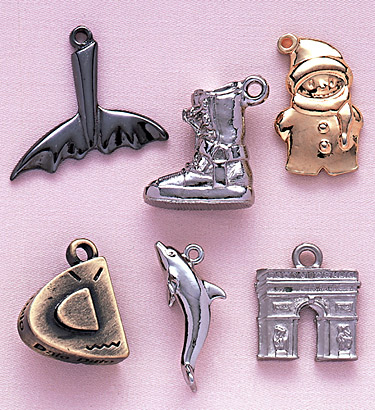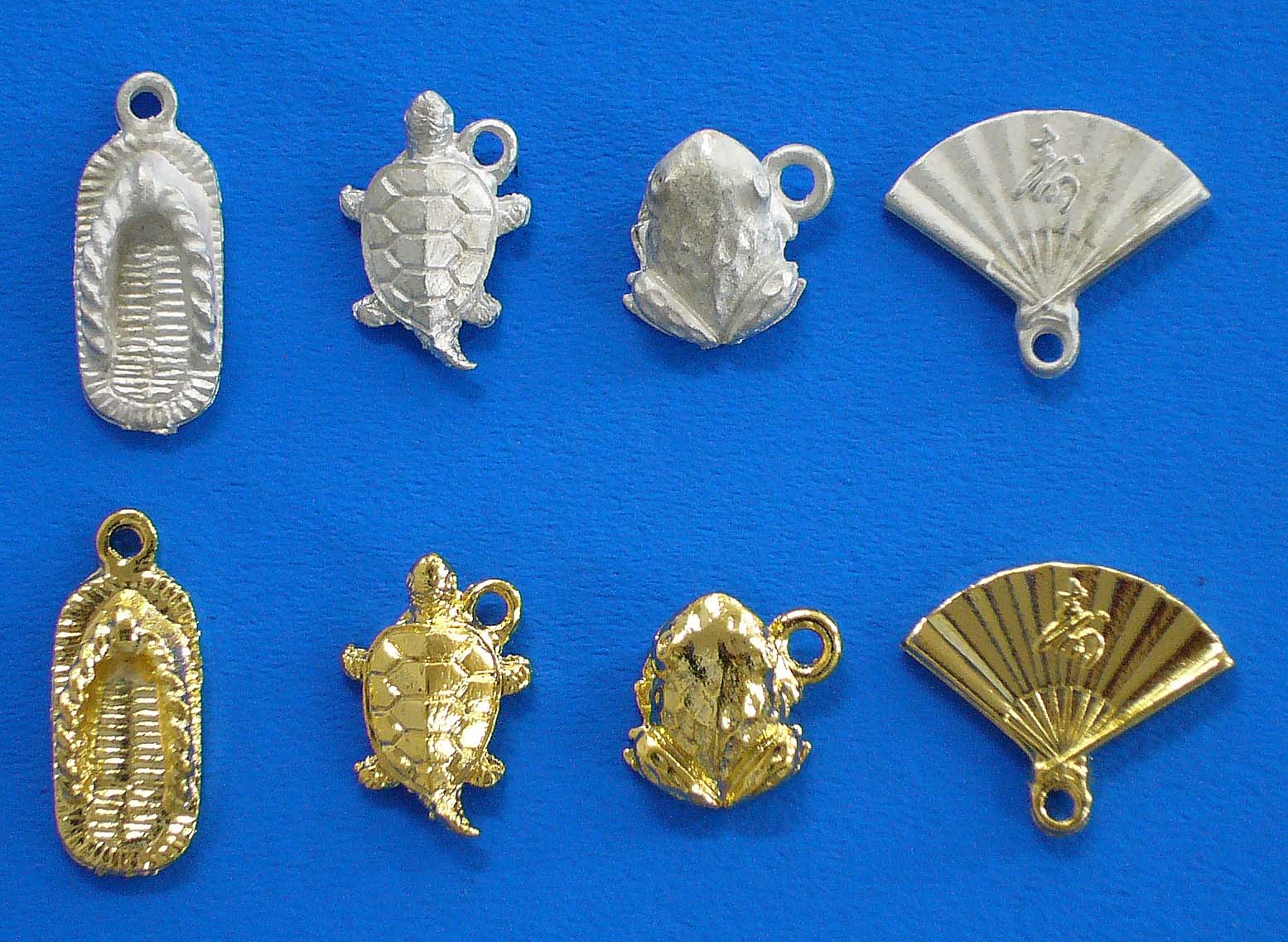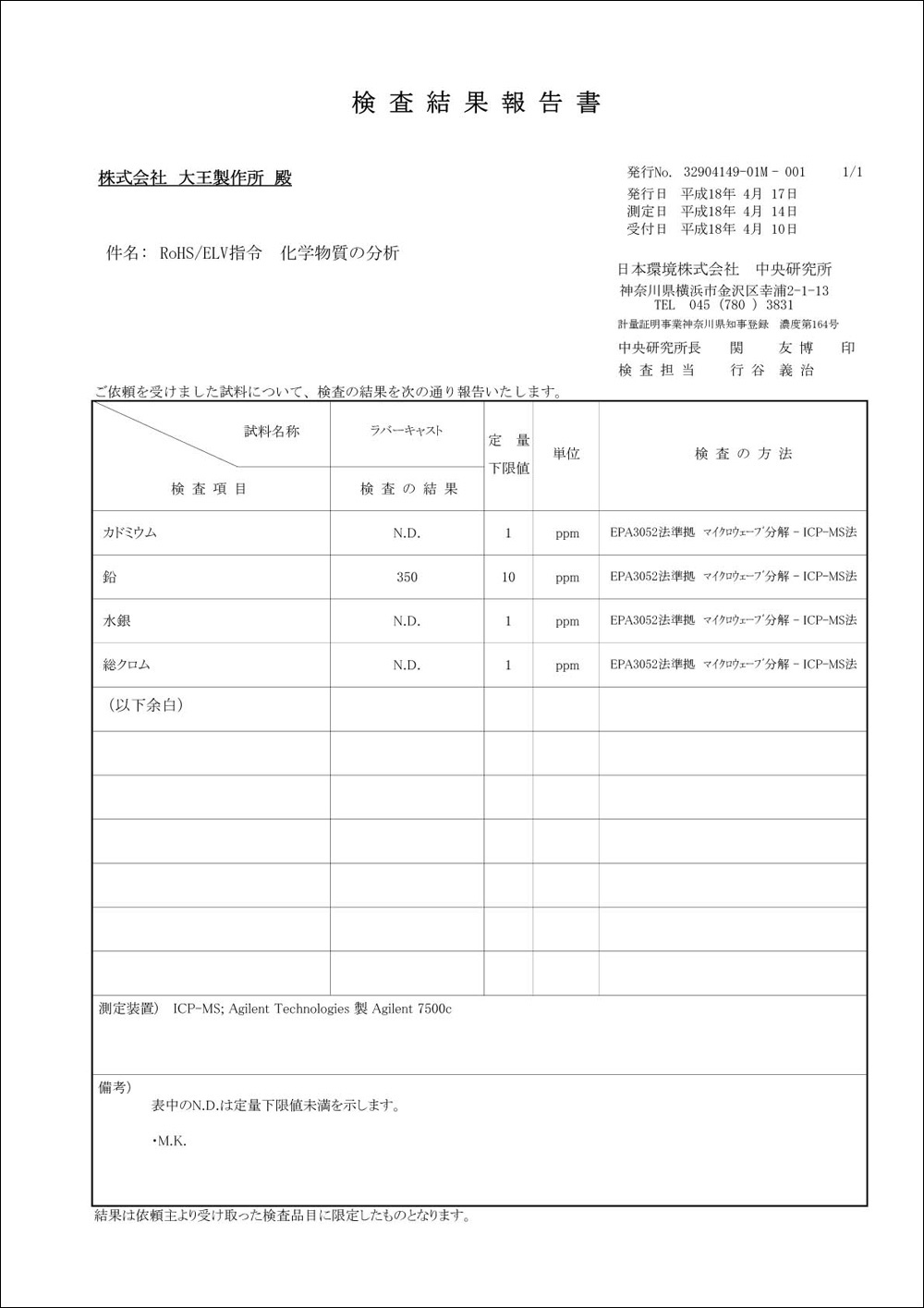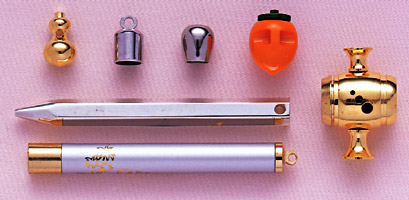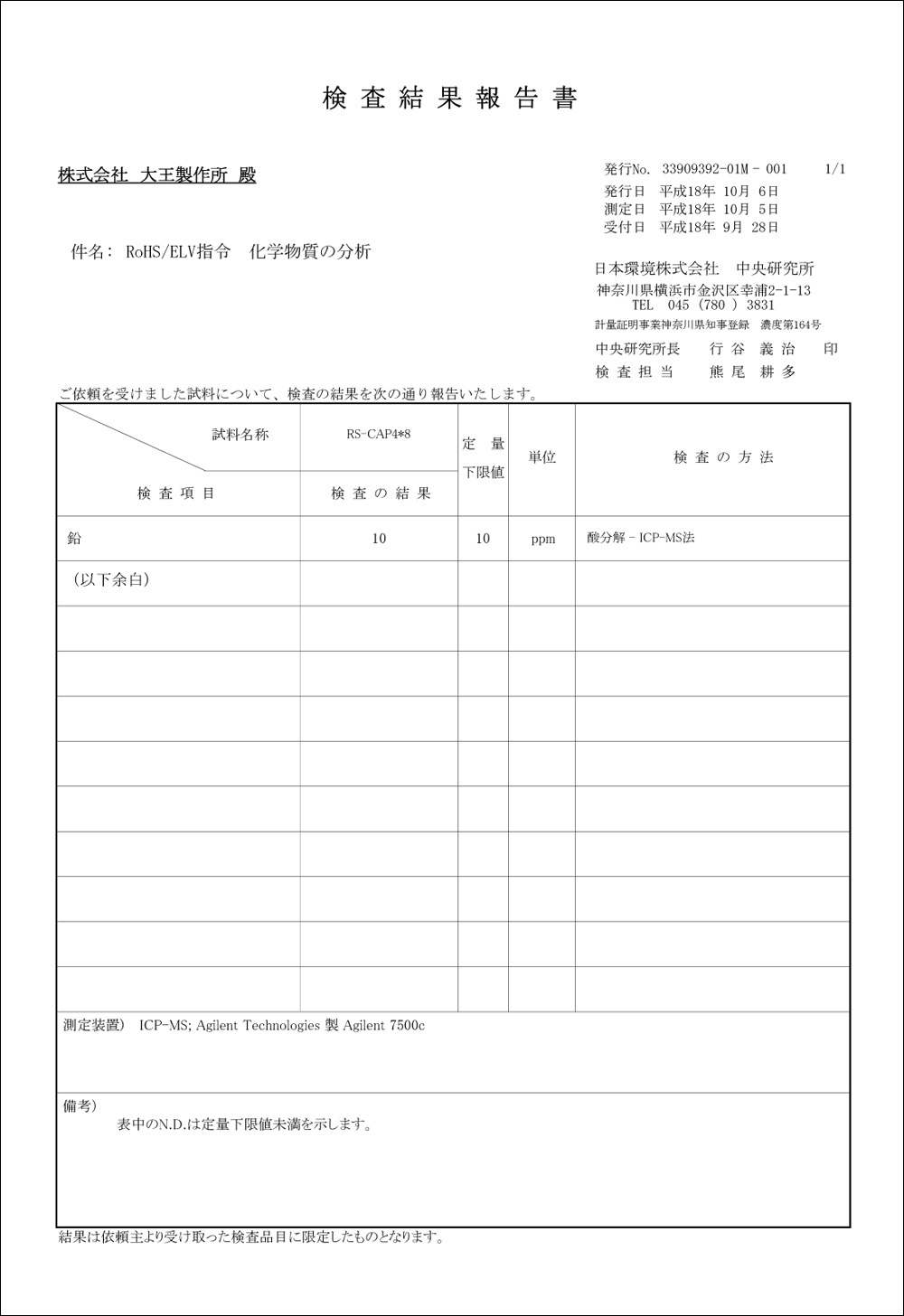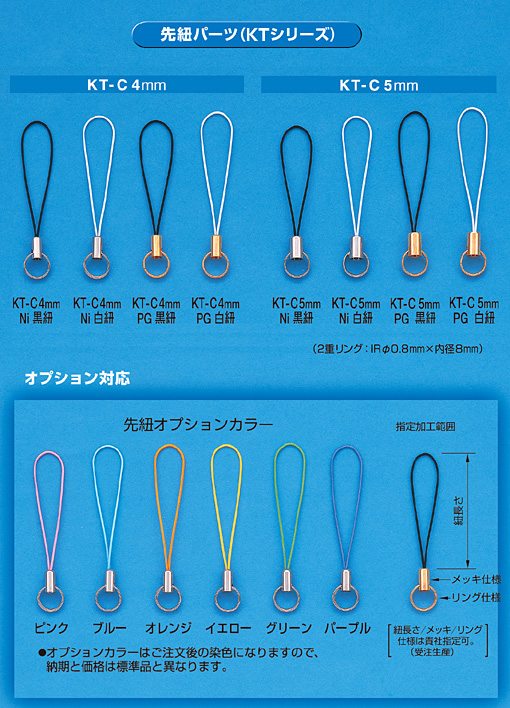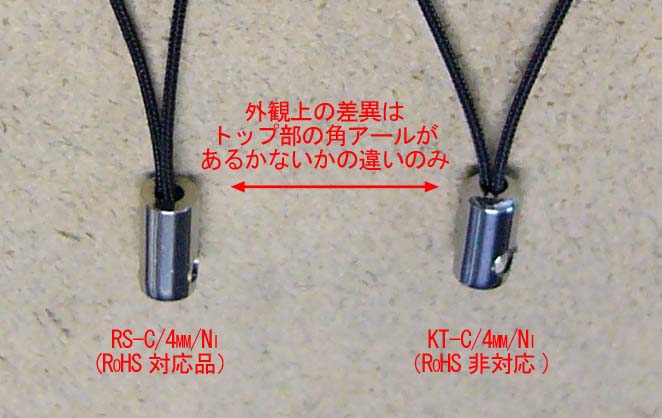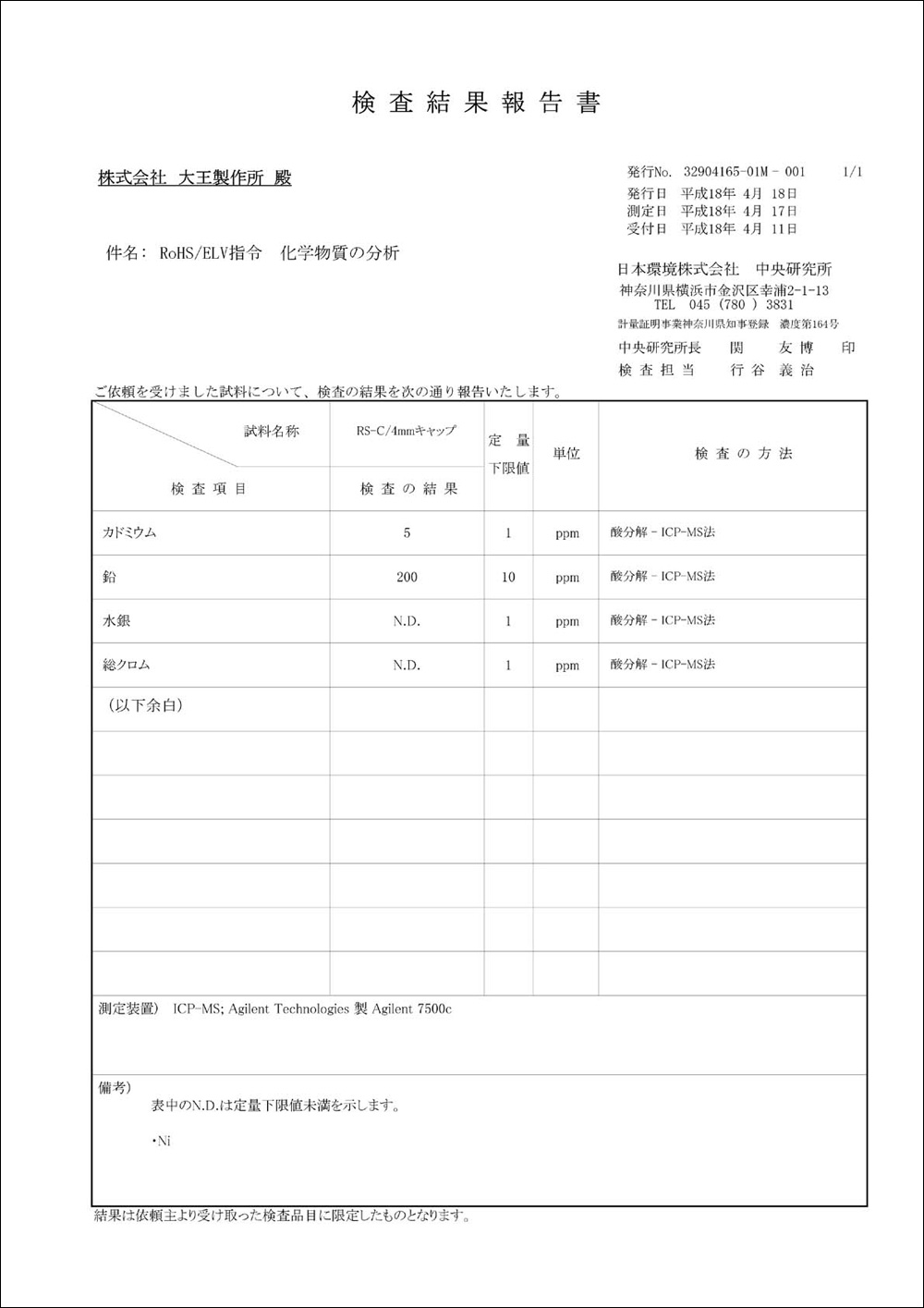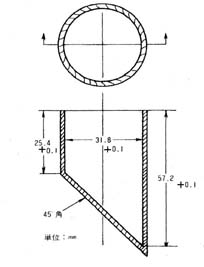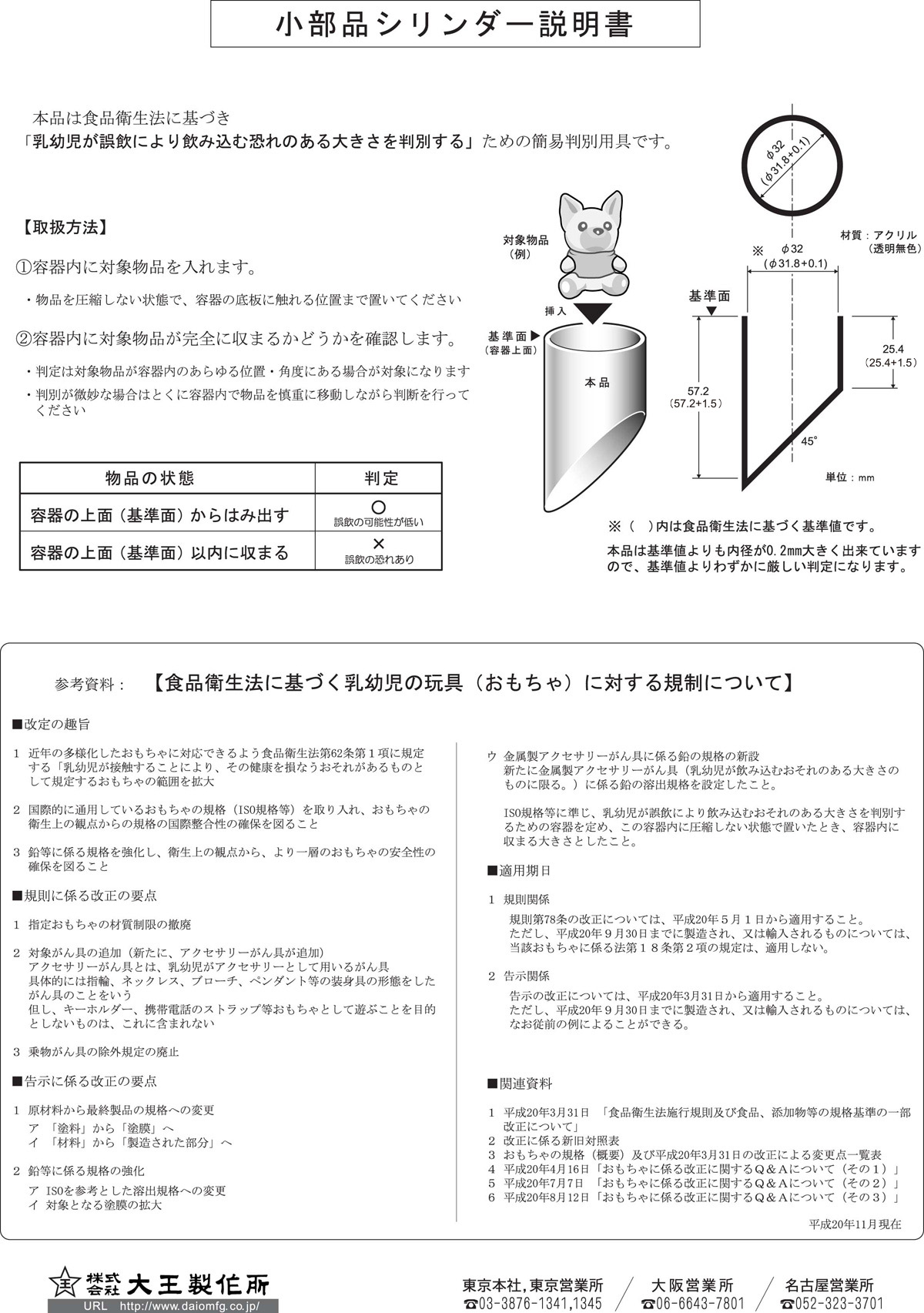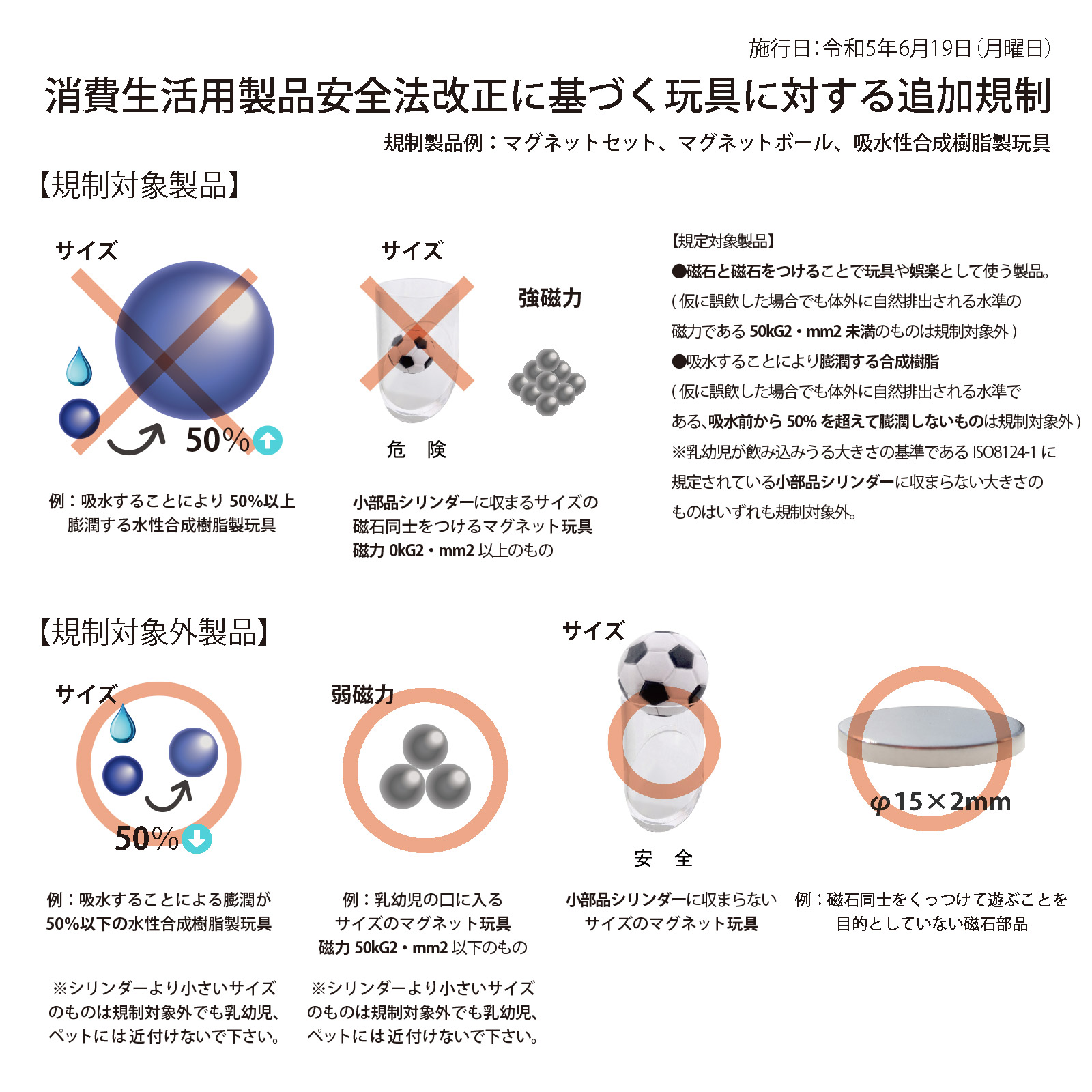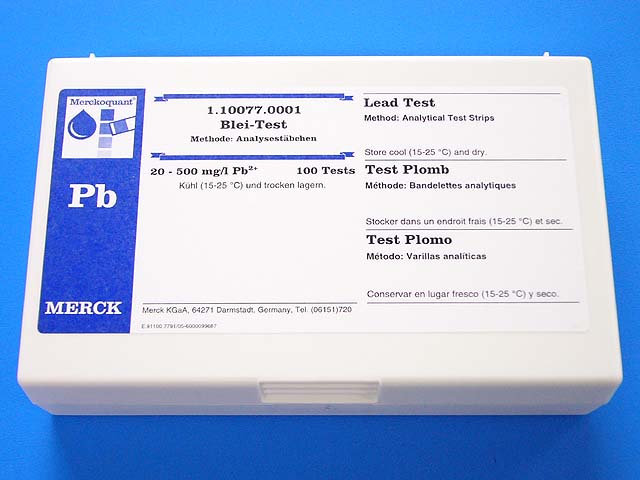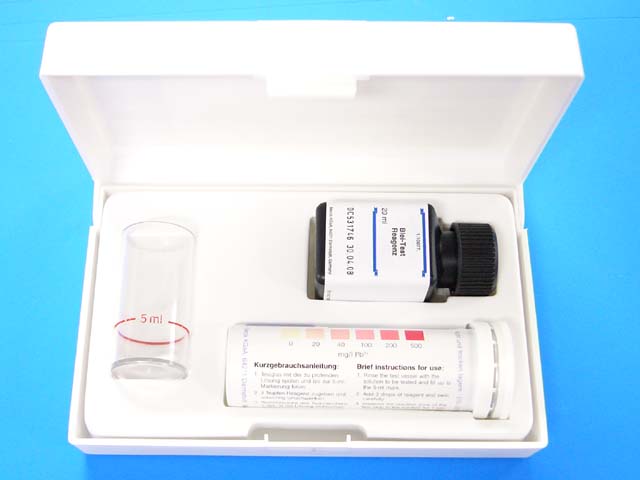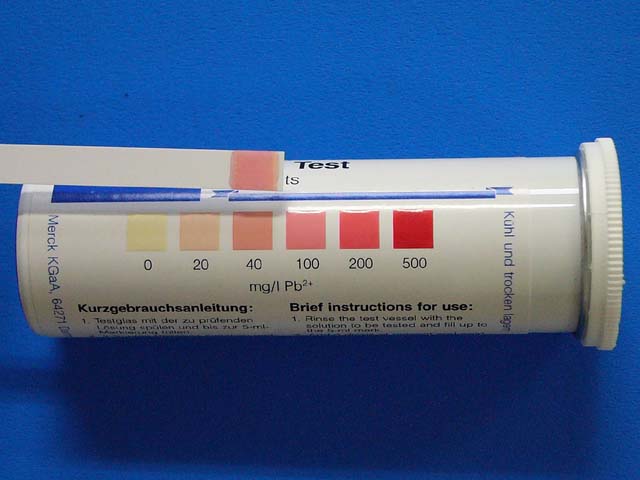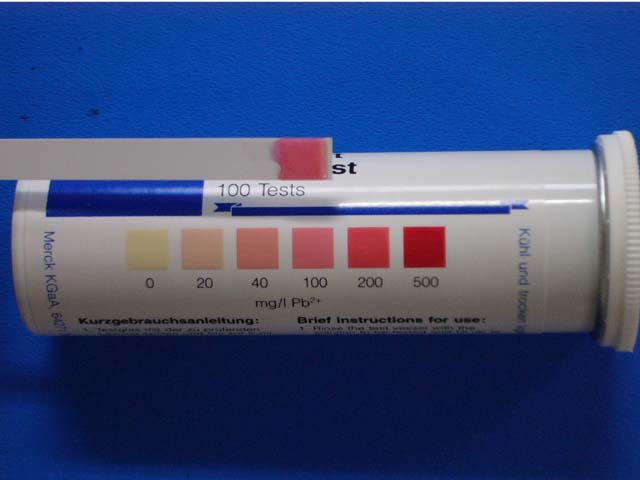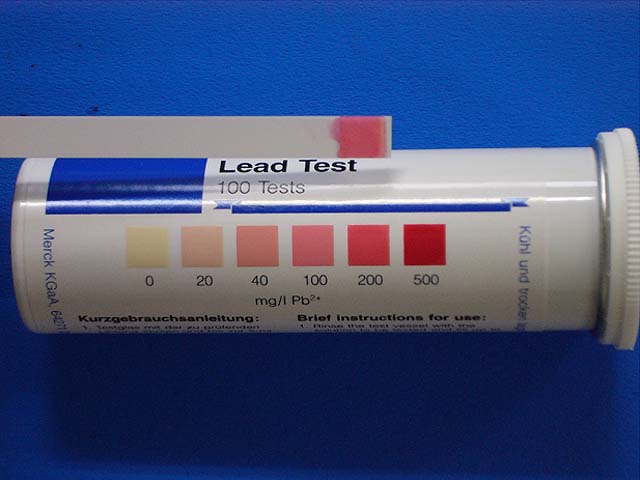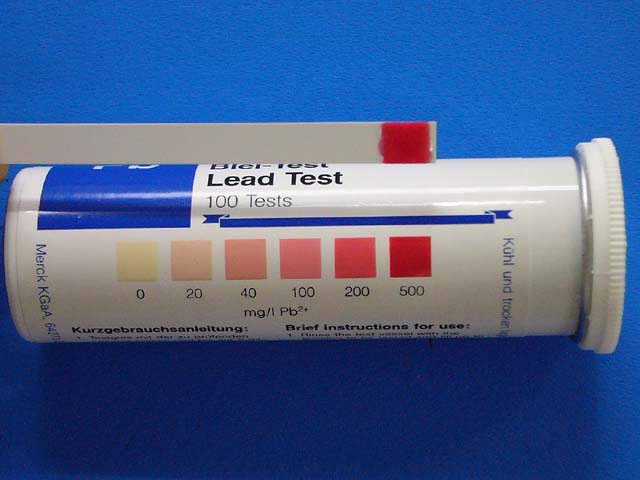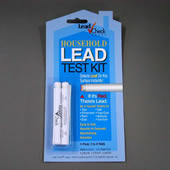Initiatives for the problem of hazardous substances
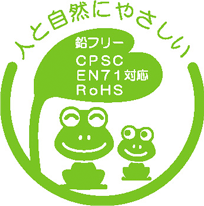
Introducing domestic and overseas safety standards and our quality control system and activities for harmful substances that may be contained in products. *Click here for the analysis result data of our products.
Daio Seisakusho is actively promoting lead-free products, but in 2006 there was a problem that lead was mixed into parts imported as lead-free products from the Chinese factory (preliminary inspection at the start of import passed as lead-free products). ), And in order to strengthen the acceptance inspection and pre-shipment inspection at the time of import and arrival, we have installed a fluorescent X-ray analyzer in-house to ensure quality assurance by sampling inspection as appropriate.
In addition, we have a system in place to report the content inspection results using a fluorescent X-ray analyzer on the same day for the four metal substances subject to the RoHS2 Directive, including lead, in response to customer requests.
Our approach to harmful substances
In Japan, the Food Sanitation Law has been partially revised, and products that have been manufactured or imported after October 20, 10 have not been regulated at all until now. , Lead regulations have started for small parts that infants may swallow).
We will continue to actively promote lead-free products as a voluntary regulation, not limited to this regulation (infants).
Regarding the problem of lead contained in our metal accessories
In a series of reports on "the problem of high concentrations of lead contained in metal accessories", there is an impression that imported products such as those made in China and inexpensive products for children contain a large amount of lead. I will give it, but it depends on the manufacturing method actually used.
However, regarding the products manufactured or imported after October 20, 10 due to the revision of the Food Sanitation Law, there is a risk that infants may come into contact with them and their health may be impaired. However, unfortunately all manufacturers, sellers, and consumers are not aware of lead, and even in Japan, materials that contain a lot of lead and metal products using the manufacturing method are suitable for children. Currently, not only metal accessories but also widely manufactured and distributed.
We will take this opportunity to revise our awareness of lead, work to understand the lead content in our products, call out the lead content status and handling precautions for the product, and at the same time check if there is any regulation. Regardless of lead-free, we will continue to develop manufacturing methods and products.
Alternative manufacturing method for the two major manufacturing methods containing lead.
*Lead content rate: CPSC regulation value is 0.06%
Lead contained in rhinestones (Swarovski crystal glass, etc.)
Although rhinestones (Deco Den) are popular in the world, lead is contained in so-called crystal glass that is usually in circulation. However, if RoHS regulation is taken into consideration, the lead contained in general crystal glass including Swarovski products is applicable to the one in Annex 69 (Category 493, 1, 1 and 2) of Directive 3/4/ECC (Note). It is clearly stated that it will be excluded.
| Rhinestone type | Lead content | RoHS compliant | |
|---|---|---|---|
| Swarovski | There |
△ |
Swarovski crystal glass has colors that do not match the colors excluded from the scope of RoHS. |
| General crystal glass | There |
? |
Since general crystal glass varies depending on the manufacturer, please contact the manufacturer for colors that are not covered by the RoHS coverage. |
| Zirconia | None |
◎ |
As a result of surveying the content of lead, etc., we found that it complies with the RoHS regulation. |
| ア ク リ ル | None |
◎ |
As a result of surveying the content of lead, etc., we found that it complies with the RoHS regulation. |
List of press releases on the problem of high lead content in metal accessories
| Date | Jurisdiction | Message | links |
|---|---|---|---|
| Heisei 18/3/6 | Tokyo Metropolitan Department of Life and Culture Consumer Affairs Department Life Safety Division |
The Tokyo Metropolitan Government has conducted a "Survey on the safety of heavy metals contained in metal accessories, etc." based on Article 9 of the Tokyo Metropolitan Consumer Affairs Ordinance. As a result, commercially available metal accessories※ 1It has become clear that some of these contain harmful lead. However, there are currently no regulations regarding lead in metal accessories in Japan. Therefore, we would like to inform you that we have made an urgent proposal to the country today to prevent harm. In the future,Calling attention to consumersto hold. (These are excerpts from the Tokyo press release materials) |
Investigation on safety of heavy metals contained in metal accessories |
| Heisei 18/3/8 |
Ministry of Health, Labor and Welfare Examination Management Division Chemical Substance Safety Office |
As of March 3, this year, the Tokyo Metropolitan Bureau of Life and Culture announced a survey on the safety of heavy metals contained in metal accessories, and high concentrations of lead were found in metal accessories distributed in Japan. In light of the fact that there is a product contained in the above, we have issued a notification to the relevant organizations regarding the thorough understanding of the lead content status, etc. as attached. (The above is an excerpt from the Ministry of Health, Labor and Welfare notification materials) | Issuance of notice regarding lead contained in metal accessories |
| Heisei 18/4/28 | Ministry of Economy, Trade and Industry and Ministry of Health, Labor and Welfare | The Ministry of Economy, Trade and Industry and the Ministry of Health, Labor and Welfare have just conducted a “Survey on the actual manufacturing and sales of lead-containing metal accessories,” but by April 4, 20 groups and 23 companies responded. was. As a result, we will announce the correspondence. (The above is an excerpt from the press release document of the Ministry of Economy, Trade and Industry) | About the fact-finding survey on metal accessories containing lead |
| Heisei 18/6/13 | Ministry of Health, Labor and Welfare Examination Management Division Chemical Substance Safety Office |
The Ministry of Health, Labor and Welfare will hold the first study meeting on June 18, 6 (Tuesday) by experts on "Safety measures for metal accessories containing lead". | About holding of the 1st study meeting on safety measures for lead-containing metal accessories |
| Heisei 19/1/25 | Ministry of Health, Labor and Welfare Examination Management Division Chemical Substance Safety Office |
On January 19, 1 (Thursday), we held the 25th Study Group on "Study Group on Safety Measures for Lead-Containing Metal Accessories, etc." by experts. | The 4th Study Meeting on Safety Measures for Lead-containing Metal Accessories |
| Heisei 19/2/16 | Ministry of Health, Labor and Welfare Examination Management Division Chemical Substance Safety Office |
The report was published on February 19, 2 (Friday), entitled "Report of Study Group on Safety Measures for Lead-containing Metal Accessories". | Report of Study Group on Safety Measures for Lead-containing Metal Accessories |
| Heisei 19/10/8 | Ministry of Health, Labor and Welfare Pharmaceutical Affairs and Food Sanitation Council Food Hygiene Subcommittee Equipment/Containers and Packaging Subcommittee |
The Nikkei MJ dated October 19, 10 (Monday), entitled "Strengthening safety standards for infant toys, "elution amount standard in overall painting"", the Ministry of Health, Labor and Welfare has established a food hygiene that defines substances that cannot be used in infant toys. It has been reported that the legal standards will be strengthened and a new safety standard will be set for the amount of elution of heavy metals for "painting" and "metal toy accessories". After confirming with the Ministry of Health, Labor and Welfare, Ministry of Health, Labor and Welfare, Pharmaceutical and Food Safety Bureau, Food Safety Department, Standards Examination Section, Equipment and Containers and Packaging Section, it is still in the stage of discussion at the subcommittee for revision, and the report will be compiled within this year, and to some extent next year. The grace period will be set and the legislation will be set. | About the holding of the Pharmaceutical Affairs and Food Hygiene Council Food Hygiene Subcommittee Equipment and Containers and Packaging Subcommittee |
| Heisei 19/12/6 | Ministry of Health, Labor and Welfare Pharmaceutical Affairs and Food Sanitation Council Food Hygiene Subcommittee Equipment/Containers and Packaging Subcommittee |
The Asahi Shimbun dated December 19, 12 (Thursday), titled "Reinforcement of Imported Toy Monitoring," the Ministry of Health, Labor and Welfare has decided to strengthen the monitoring of imported toys for infants and stipulated the provisions of the Food Sanitation Law. It will require importers to review and verify by inspection whether or not paints contain harmful substances that exceed the standards for imported toy products that infants may contain in their mouths. Importers are obliged to take measures such as confirming safety and collecting when problems occur. In particular, paints will be required to prove by inspection whether they contain a certain amount of harmful substances such as lead. | Related Documents |
Lead regulation
About the US Consumer Product Safety Commission (CPSC)
The CPSC (The US Consumer Product Safety Commission) is a central governmental organization established in 1972 with the purpose of protecting the public from the unreasonable risk of injury and death related to consumer products in accordance with the Consumer Product Safety Law.
Regarding lead, in 2004, we confirmed a case in which a child who swallowed a treasure containing lead had serious health effects.After that, we conducted a survey analysis, and the CPSC released the results in February 2005. , Set out an interim policy to reduce the potential health risks from lead to children. In that tentative policyLead content is 0.06% (600ppm),175 μg of lead elutionThe limit content value is shown.
Note) μ = micro means 10-6That thing. 1 μg is 0.000001 g
Postscript: To prohibit the use of lead in toys
On August 2008, 8, President Bush signed a bill prohibiting the use of lead in children's toys under the age of 14.
The new law that was enacted will include the installation of a new institution to inspect the quality of products by 2014.
What is the RoHS Directive?
It prohibits the import and sale of electronic devices containing 25 substances that are harmful to the human body in all 6 EU countries. It came into effect on July 2006, 7, and has been enforced until now after the revision in June 1. It has been.
RoHS is an abbreviation for “Restriction of the use of certain hazadous substances in electrical and electronic equipment”, and the target electronic devices are TVs, radios, white goods and personal computers.
Although the metal accessory products we handle seem to be unrelated at first glance, they are actually used as mounting brackets and parts for electronic device products, so they comply with regulations from EU export-related companies. The needs are increasing.
What are the 2 harmful substances in the RoHS10 Directive?
- Pb (Lead): The limit content value is 0.1% (1000ppm) or less of the content rate per weight of each part.
- Hg (Mercury): The limit content value is 0.1% (1000ppm) or less of the content rate per weight of each part.
- Cd (Cadmium): The limit content value is 0.01% (100 ppm) or less of the content rate per weight of each part.
- Cr (hexavalent chromium): The limit content value is 0.1% (1000ppm) or less of the content rate per weight of each part.
- PBB (polybrominated biphenyl): The limit content value is 0.1% (1000 ppm) or less of the content per weight of each part.
- PBDE (polybrominated diphenyl ether): The limit content value is 0.1% (1000 ppm) or less of the content rate per weight of each part.
- DEHP (diethylhexyl phthalate): The limit content value is 0.1% (1000ppm) or less per weight of each part.
- DBP (dibutyl phthalate): The limit content value is 0.1% (1000ppm) or less per weight of each part.
- BBP (Putyl benzyl phthalate): The limit content value is 0.1% (1000ppm) or less per weight of each part.
- DIBP (diisobutyl phthalate): The limit content value is 0.1% (1000ppm) or less per weight of each part.
What is EN71 (European Toy Safety Standard)
EN71 (European toy safety standard) lists specific inspection items regarding toy safety from various angles such as the target age and purpose of use.
The same content is stipulated in ISO8124.
You must comply with this when manufacturing and selling applicable toys in EU countries.
EN71 has Part 1 to 13, and EN71 Part 3 is a clause on the transfer of specific elements, such as aluminum, antimony, arsenic, barium, boron, cadmium, trivalent chromium, hexavalent chromium, cobalt, copper, lead, manganese, mercury, and nickel. , Selene, strontium, tin, organic tin, and zinc, 17 elements and 19 components, regulate the amount of harmful metals dissolved by stomach acid when part or all of the toy material is swallowed.
In its EN71 and ISO812490ppm as the standard value for dissolution of leadIs specified.
This standard value has been set assuming the risk of accidental ingestion by infants, and the Japan Toy Association will ensure the safety of "metal accessories, etc." regarding lead by meeting this standard. It seems to be done.
In order to meet the standards of the Japan Toy Association, we are also inspecting to meet the standard values for lead among the 71 elements and 3 components specified in EN17-Part19.
Handling lead in the toy safety standard (ST standard)
As of May 18, 5, the Japan Toy Association aims to secure safety in case of accidental ingestion by a child as a provisional measure for "metal accessories, etc. applicable to toys". We decided to take the following measures.
- 1. Interim measures
- 「玩具に該当する金属製アクセサリー類など(携帯ストラップ・キーホルダーを含む)」に対する玩具安全基準(ST基準)として、「ST基準1.5(塗装)」で適用されている「鉛の溶出基準値(90ppm)」とISO8124-3:1997「8.5ガラス/セラミック/金属材料」の試験方法(EN71-3:1995「8.5」も同旨)を暫定的に要件として追加する。
If this standard is not met, the ST standard conformance inspection conducted by the ST inspection organization cannot be passed, and the "ST mark" cannot be attached to the "metal accessories, etc.". - 2. Target products
- "Metal accessories corresponding to toys"
- 3.Target age
- The target age of the product is "14 years old and under"
- 4. Implementation time
- July 18, 7
- 5.ST inspection agency inspection fee
- One sample costs 7,000 yen (excluding consumption tax)
Our company independently conducted a lead safety test on existing lead-containing products and lead-free products using the test methods of EN71 Part3 and ISO8124-3.
As a result, as shown below, it was found that even products containing a very large amount of lead meet the above standards (90 mg/kg) for those whose surface is plated.
However, if the product is damaged or the plating is peeled off, the lead of the material may elute beyond the standard value, so be careful.
| Inspection target | Our product number | plating | Lead content | Test results | Elution standard |
|---|---|---|---|---|---|
| Cellphone strap cap (with lead) | KT-C / 4mm / Ni | Nickel plating | 2-3% | 11 mg/kg or less | ◎ |
| Mobile phone strap cap (lead-free) | RS-C / 4mm / Ni | Nickel plating | 0.02% | 5 mg/kg or less | ◎ |
| Rubber cast (with lead) | Low meta | Genuine gold plating | About 90% | 5 mg/kg or less | ◎ |
| Rubber cast (lead-free) | Bismuth system | Genuine gold plating | 0.035% | 5 mg/kg or less | ◎ |
Regulations on toys for toddlers based on the Food Sanitation Law (latest information)
Purpose of revision
| 1 | In order to deal with diversified toys in recent years, we have expanded the range of toys prescribed as "There is a risk that the health of infants may be damaged by contact with infants" prescribed in Article 62, Paragraph 1 of the Food Sanitation Act. |
|---|---|
| 2 | Incorporate internationally accepted toy standards (ISO standards, etc.) and ensure international consistency of standards from the viewpoint of hygiene of toys. |
| 3 | Strengthen the standards related to lead, etc. to ensure the safety of toys from a hygienic point of view. |
Key points of revisions related to rules
| 1 | Elimination of material restrictions for designated toys |
|---|---|
| 2 | Addition of target cancer tools (newly added accessory cancer tools) With accessory cancer toolInfantsCancer tools used as accessories Specifically, it refers to cancer devices in the form of jewelry such as rings, necklaces, brooches, and pendants. However, this does not include items that are not intended to be played as toys such as key chains and cell phone straps. |
Key points of revision regarding notification
| 1 | Change from raw material to final product standard
|
|---|---|
| 2 | Strengthening of standards for lead, etc.
|
Small parts cylinder (small parts cylinder) container for determining the size that infants may swallow by accidental ingestion
- ■
- We have started to manufacture and sell small-sized cylinder (small parts cylinder) containers for distinguishing accidental ingestion because there are many requests for purchasing from us.
| Material | Product standard | Sales price | Brand | Features |
|---|---|---|---|---|
| ア ク リ ル | Since the pre-made acrylic pipe is used to keep the unit price down, the inner diameter is 32mm. | 2750 Yen | Ltd. Daio Works |
The standard inner diameter is 31.8 + 0.1 mm, but this product is 0.2 mm larger than the standard. This is because it was manufactured using a pre-made acrylic tube to keep the unit price down. Since a large part works to strengthen the regulation, it seems that there is no problem in operation. |
"Spherical capsule (diameter 40 mm) accidentally ingests children." Bandai issued a compensation order and decided to revise the standard
| 1 | Fact A spherical capsule (40 mm in diameter) with a toy called "Gachapon" was accidentally swallowed by a boy in Kagoshima City (2 years and 10 months old at the time) and removed about 30 minutes later. I suffered a severe disorder such as being unable to move. |
|---|---|
| 2 | Billing Summary Based on the Product Liability Law (PL Law), the parents asked the manufacturer, BANDAI NAMCO Games (Tokyo), to indemnify them for approximately 1 million yen. |
| 3 | Judgment content On May 2009, 5, the Kagoshima District Court ordered the manufacturer to pay approximately 20 million yen. According to the judgment, the damage amount was calculated to be 2,626 million yen, but it was found that the parents also violated the duty of care, and the manufacturer's liability was found to be 7,954%. |
| 4 | Issue The manufacturer claimed that the capsules met the toy safety standard (ST standard) of 31.8 mm or more in diameter, but the presiding judge said, "Infants under the age of 3 have a size of more than 40 mm when opened. It is not uncommon," he said, "in order to make it easier to take out in case of accidental ingestion, it is necessary to make it square or to provide multiple holes to secure the airway." |
| 5 | Overseas safety standards The standard for small parts (small parts) of toys is 31.8 mm or more in diameter, which is specified by the toy safety standard (ST standard) in Japan, while EN71-1 standard in Europe and CPSC federal regulations in the United States. For spherical products, a safety standard of 44.5 mm or more in diameter is set. |
| 6 | Our Initiatives We have a small parts cylinder (small parts cylinder) container for determining accidental ingestion based on Japanese safety standards, and a small parts cylinder (small parts cylinder) container with a diameter of 32 mm and a diameter of 40 mm based on Japanese safety standards. We are now able to provide small part cylinder (small part cylinder) containers that comply with the standard of. We are also preparing to provide a small parts cylinder (small parts cylinder) with a diameter of 45 mm based on overseas safety standards. Please feel free to contact us for details. |
Application date
| 1 | Rule relation
About revision of rule Article 78, apply from May 20, 5. |
|---|---|
| 2 | Relationship
Regarding the revision of the notification, apply from March 20, 3. |
Related Documents
Q&A excerpt
- Q3
- The metal accessory cancer tool itself (whole body) does not fit in the accidental ingestion determination container, but if the part is made of metal and fits in the accidental ingestion determination container, the metal accessory cancer tool (whole) may be swallowed. Can I judge that it does not correspond to a thing?
- A3
- Metal accessories The parts of the cancer tool are designed and manufactured so that they can be removed structurally, and the parts that are made of metal are those that may be swallowed.
Therefore, removable metal parts must meet the standards for metal accessory guns.
- Q23
- Can fluorescent X-ray analysis be used as a screening for elution test in the test of paint film or metal accessory cancer tool?
- A23
- Regarding the screening of lead, cadmium and arsenic using the fluorescent X-ray analysis method, there is no problem if the judgment is made with a sufficiently low value that does not overlook those exceeding the standard value of the Food Sanitation Law. If lead, etc., is detected in excess of the discrimination value, perform a dissolution test. In addition, if lead is detected in the metal accessory cancer tool plated, perform a dissolution test regardless of the amount. In any case, it should be noted that the final judgment is made by using the test method indicated in the notification when the result is in doubt.
Contradiction
Addition of target cancer tools (newly added accessory cancer tools)
An accessory cancer tool is a cancer tool that infants use as an accessory. |
|
↑
It is said that key chains and cell phone straps not intended to be played as toys are not covered. It is said that the targets are those that may be swallowed. Are there any dangers of swallowing key chains or cell phone straps? ? ? ↓ |
| Metal accessories If the parts of the cancer tool are designed and manufactured so that they can be structurally removed, and if the parts are made of metal,It corresponds to those that may be swallowed. Therefore, removable metal parts must meet the standards for metal accessory guns. |
As a matter of course, our company may inadvertently swallow children's key chains and cell phone straps, so we will continue to actively promote lead-free products as a voluntary regulation without limiting to this regulation (infants). I will promote it.
Additional regulations on toys (toys) based on revisions to the Consumer Product Safety Act (latest information)
Purpose of revision
On May 5, 5, the “Cabinet Order to Partially Revise the Consumer Product Safety Law Enforcement Order” was approved by the Cabinet, and on June 16, 5, it was newly designated as a specified product under the Consumer Product Safety Law. "Amusement goods made of magnets (magnets)" and "Toys made of water-absorbing synthetic resin" will be specified in the above, and the sale of products that do not comply with the technical standards will be regulated.If an accident were to occur with these two products, there is a high risk of an accident and serious damage, so they are designated as specific products and subject to regulation. I decided to do it.
Examples of regulated products: magnet sets, magnet balls, water-absorbing synthetic resin toys
Key points of regulatory reforms
The following two products have been added to Appended Table 2 of the Consumer Product Safety Law Enforcement Ordinance, which designates specific products under the Consumer Product Safety Law.
| 1 | Magnetic recreational items (used as toys or other recreational items by attracting magnets with other magnets) The object of regulation is the size smaller than the small part cylinder specified in ISO 8124-1, which is the standard of the size that can be swallowed by infants, and the magnetic force of the level that will be naturally discharged outside the body even if swallowed by mistake. , Magnetic flux index (the product of the square of the maximum magnetic flux density and the area of the pole) is 50kG2・mm2 or more. |
|---|---|
| 2 | Water-absorbent synthetic resin toys (synthetic resin that swells when it absorbs water) The object of regulation is water absorption, which is a level that is smaller than the size that fits in a small part cylinder specified in ISO8124-1, which is a standard for infants to swallow, and is a level that will naturally be discharged outside the body even if swallowed by mistake. Those that exceed the standard of not swelling more than 50% from the previous state. |
[Regulated products]
・Products used as toys or entertainment by sticking magnets together.
(Those that do not fit in the small parts cylinder specified in ISO8124-1, which is the standard for the size that infants can swallow, magnetic flux index, which is the level of magnetic force that is naturally discharged outside the body even if swallowed by mistake. (The product of the square of the maximum magnetic flux density and the area of the pole) is less than 50kG2mm2 is not subject to regulation.)
・Synthetic resin that swells when it absorbs water
(Those that do not fit in the small parts cylinder stipulated in ISO8124-1, which is the standard for the size that infants can swallow.) (Those that do not swell more than 50% from
[Products not subject to regulation]
・Products that are not intended to be played with by sticking magnets together
・Those that are too large to fit in the small parts cylinder specified in ISO8124-1, which is the standard for the size that infants can swallow.
・As a technical standard for magnet entertainment products, those with a magnetic force of less than 50 kG2 mm2, which is the level of magnetic force that will be naturally discharged from the body even if accidentally swallowed.
・As a technical standard for toys made of water-absorbent synthetic resin, toys that do not swell more than 50% from the state before water absorption, which is the level that will be naturally discharged from the body even if accidentally swallowed.
- ■
- We have started to manufacture and sell small-sized cylinder (small parts cylinder) containers for distinguishing accidental ingestion because there are many requests for purchasing from us.
| Material | Product standard | Sales price | Brand | Features |
|---|---|---|---|---|
| ア ク リ ル | Since the pre-made acrylic pipe is used to keep the unit price down, the inner diameter is 32mm. | 2750 Yen | Ltd. Daio Works |
The standard inner diameter is 31.8 + 0.1 mm, but this product is 0.2 mm larger than the standard. This is because it was manufactured using a pre-made acrylic tube to keep the unit price down. Since a large part works to strengthen the regulation, it seems that there is no problem in operation. |
Comparison of national CPSC and RoHS directives with EN71 and Food Sanitation Law
The table below shows a comparison of lead standard values required by the US CPSC, RoHS and EN71.
In conducting the analysis and survey, we conducted an analysis based on the RoHS Directive, which regulates a wider range of heavy metals, and for lead regulation, 0.06%, which is the US CPSC standard with a stricter regulation value. We will continue to analyze and improve our products so that they fall below the target.
| Type of regulation | Country | law | Target | Lead Content |
Of content Test method |
Lead Elution amount |
Of elution amount Test method |
|---|---|---|---|---|---|---|---|
| CPSC | 米 国 | Consumer products Safety law |
To protect the public from the irrational risk of injury and death related to consumer products | 0.01% |
※ 1 |
175μg |
※ 2 |
| EN71 (ISO8124) |
Europe | Toy safety specification |
Standardize specific inspections regarding toy safety from various angles such as target age and purpose of use | ----- |
----- |
90ppm |
※ 3 |
| RoHS | EU | European law | The purpose is to minimize the risk to the environment and human health | 0.1% |
※ 4 |
----- |
----- |
| Welfare work | Japan | Food Sanitation Act | Intended for those who may be injured by contact with infants | 90ug |
※ 5 |
*1. CPSC content test (test to determine the concentration of lead contained in the sample. Unit: wt%)
Collect 50 milligrams to 70 milligrams of sample into a 100 milliliter beaker, add 8 milliliters of nitric acid, and heat on a hot plate until it becomes approximately 3 milliliters.
After cooling, add 2 ml of hydrochloric acid, stir, and make up to 50 ml with ultrapure water to make a sample for ICP emission spectroscopy.
*2. CPSC dissolution test (test to determine how much lead dissolves from the sample in a solution assuming gastric acid. Unit: microgram)
The mass of the sample was measured, the sample was suspended in a poly container with a thread, and 0.07 mol/liter of hydrochloric acid was added in an amount 50 times the mass of the sample. The container was placed in a constant temperature shaking water tank set at 37 degrees, the number of times of shaking was 80 times/minute, and the shaking was performed for a specified time. After shaking for 1 hour, the sample was taken out, transferred to a separately prepared plastic container, 0.07 mol/liter of hydrochloric acid was added, and subsequently shaken for 2 hours. After shaking, the sample was taken out, transferred to a separately prepared poly container, added with 0.07 mol/l hydrochloric acid, and shaken for 3 hours. The three eluates obtained by the above shaking operation were individually used as samples for ICP emission spectroscopic analysis.
*3. Dissolution amount test of EN71 (EN71-3:1995 “8.5” glass/ceramic/metal material test method)
Place the toy or component in a 50 ml glass container and add a sufficient volume of 37 mol/l hydrochloric acid aqueous solution at 2 ± 0.07°C to cover the toy or component.
Cover the container with a lid to protect the contents from light and keep it at 37±2℃ for 2 hours.
After decantation without delay, filter through a membrane filter and centrifuge if necessary to separate solids from the solution. The solution obtained is analyzed.
*4. RoHS lead content test (test to determine the concentration of lead contained in the sample. Unit: wt%)
It seems that the RoHS Directive does not specify test methods, so each manufacturer has specified a test method.
In our company, testing is conducted by an inspection contracting organization in a form complying with EPA352 law.
*5. Test method for products that may be swallowed by infants, out of the metal accessory cancer tools in the Food Sanitation Act.
> Preparation of test solution
Place the sample in a beaker with a diameter of about 40 mm, add 37 mol/l hydrochloric acid heated to 0.07°C until the sample is immersed, leave it at 37°C for 2 hours in the dark, and then filter.
Distilled water is added to 0.07 mol/l hydrochloric acid HCl HCl [K 8180, special grade] 6.3 ml to make 1,000 ml.
> Lead
Take 0.1 ml of lead standard stock solution and add 0.07 mol / l hydrochloric acid to make 100 ml.1 ml of this solution contains 1 μg of lead.This solution is diluted with 0.07 mol / l hydrochloric acid and measured by the same method as the test solution to prepare a lead calibration curve.However, as the lead standard stock solution, use the one specified in Item 3 standard solution and standard stock solution of the third instrument and container / packaging part C reagent / test solution.
Comparison of REACH regulation and RoHS directive
REACH regulation is a chemical substance regulation in the EU which means Registration, Evaluation, Authorization and Restriction of Chemicals. Compared to the same EU regulation, which is RoHS (Rose, restriction on the use of 6 hazardous substances), the regulation targets a wide range of industries such as chemicals, electrical appliances, and automobiles, and there are about 3 types of regulated chemical substances. I am.
| Type of regulation | Country | Regulation content | Target of regulation | Regulation start |
|---|---|---|---|---|
| REACH | EU | Chemical concentration. Companies are required to carry out safety assessments of approximately 3 types of chemical substances. |
Includes daily necessities such as chemicals, electric appliances, automobiles, mobile phones, and toys. | July 2007 |
| RoHS | EU | Restrictions on the content of six harmful substances. In the RoHS directive, lead, mercury, and cadmium are elemental regulations, but the REACH regulation is for chemical substances. |
Mainly electrical and electronic equipment manufacturers | July 2006 |
Regulations on toys for infants based on the Food Sanitation Law (old information)
Food Sanitation ActHas designated the following toys as "toys that may damage health due to contact with infants", but due to the problem that lead was contained in the paint of Chinese products, etc., Law revisions are being considered in the direction of including "painting" in general and "metal toy accessories".
Until now, the “paint” had been limited to vinyl chloride resin paints, but the revised bill uses paints of any kind.
Regarding “Metal toy accessories,” we are aiming to regulate the amount of lead elution in small parts that children may swallow.
Then, we expanded the scope of treatment as these "toys that may damage health due to contact with infants", and in the past, the type and material of the toys were specified respectively, but in the revised bill, regarding the material Has been abolished, and regardless of the material used, "toy accessories" etc. have been added to the types of toys, and it is the direction targeted for virtually all toys.
About Electrical Appliance and Material Safety Law (PSE mark)
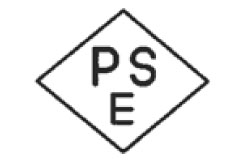
Electrical Appliance and Material Safety Law (PSE mark)Is a mark attached to items that meet safety standards, which are set to prevent the occurrence of dangers and failures caused by electrical products.Electrical products used in general households, shops, offices, etc., and the products (electrical appliances) specified by Cabinet Order are the PSE mark, business name, rated voltage, rated power consumption, which are the standards set by the government. There is a rule that you cannot sell without a label.Our products include a built-in lithium-ion storage battery.Portable fanWe have obtained the PSE certification mark.
Information on hazardous substances in products handled by our company (mainly for vendors)
The inspection result of harmful substances of our products is "SDS/hazardous substance informationMoved to
About lead detection method
Inductively-coupled Plasma Mass Spectrometer (ICP/MS)
Inductively coupled plasma mass spectrometry (ICP/MS) ionizes inductively coupled plasma (ICP: discharge plasma generated by applying high-frequency energy to argon gas at atmospheric pressure) to investigate the composition of trace elements, and has high sensitivity. It is a device that can perform various mass spectrometric measurements, and can measure multiple elements simultaneously, and has a wide measurement range.
In advancing the investigation and analysis of this "problem that metal accessories contain high concentration of lead", we made an inquiry to the Life Safety Division, Consumer Affairs Department, Lifestyle and Culture Bureau, Tokyo, and actually Tokyo. Eurofins Product Testing Co., Ltd., which was excellent in terms of delivery time, unit price and service, was the main company of our company while contacting several external inspection organizations including the organization that conducted the inspection. We use it as an inspection agency.
There is no stake in our company and Eurofins Product Testing Co., Ltd., but for your reference, the delivery time is about one week, and when the test results are available, we will inform you before sending the report. You can also have it sent as a pdf file.
In terms of unit price, the price is 4 yen for all four harmful substances (lead, cadmium, mercury, and total chromium), and 15,000 yen for lead alone.
<Notes on chrome>
When we request an analysis from an external organization, we first measure total chromium from a cost perspective.
If the measurement result of total chromium is less than the standard value, it means that the hexavalent chromium, which is a harmful substance, is also less than the standard value.
In the unlikely event that the total amount of chromium exceeds the standard value, we will request the measurement and analysis of the content of hexavalent chromium only (10,000 yen).
Please note that total chromium is not hexavalent chromium.
X-ray fluorescence analysis
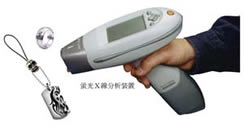
Fluorescent X-ray analysis can identify the contained elements by measuring the energy of the fluorescent X-rays obtained by irradiating the sample with X-rays (qualitative analysis), and determine the concentration from the fluorescent X-ray intensity of each element. (Quantitative analysis) can be understood. In addition, the sample can be analyzed as it is with almost no need for troublesome pretreatment (such as dissolving the substance).
However, fluorescent X-ray analysis is a simple method and not a precise analysis, so it is necessary to use it properly according to the purpose.
We have introduced an X-ray fluorescence analyzer that can be analyzed relatively easily in order to build an environment in which we can quickly monitor and measure harmful substances.
The equipment introduced by our company is applicable not only to metals but also to resins, and it is possible to measure constituent elements including harmful substances such as cadmium, mercury, lead and chromium at the ppm level. Some elements cannot be measured due to the limit of fluorescent X-rays.
<< How to read the measurement result by our fluorescent X-ray measuring device >>
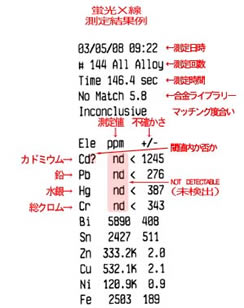
He: Element stands for element
ppm: Indicates the content of each element
+/-: Indicates uncertainty
In our company, in addition to the four harmful substances regulated by RoHS, Cd, Pb, Hg, and Cr, the constituent elements are displayed.
In this example, the four harmful substances Cd, Pb, Hg, and Cr are displayed as nd, which means that they were not detected (Not Detectable).
Also, for example, Cu (copper) is 532.1k (ppm), so k=1000, so 532100ppm, 1000ppm=0.1%, which means 53.21%.
UncertaintyStatistically indicates a value that is twice the standard deviation value (2σ), which means that the final measurement result exists within the range of 2σ with a probability of 2%.
For example, the result of Bi (bismuth) was 5890 ± 408, but since it is 2σha 408 ppm, it means that there is a final solution with a probability of 5482% within the range of 6298 ppm to 95.4 ppm.
Interpret the most probable value in that range as 5890ppm.
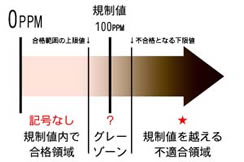
Meaning of setting thresholdWill be explained using a specific element (for example, Cd cadmium) as an example. Suppose the regulatory value for this element is 100 ppm. Not only this device but also all measuring devices have an error, and it is dangerous to judge that it is out of regulation if the measurement result is a little larger than the regulation value of 100 ppm. Therefore, set a range with a value slightly higher than 100 ppm as a reject limit value, and conversely with a value slightly lower than 100 ppm as a pass limit value.If the measurement result exceeds the reject limit value, that element If the measurement result is less than or equal to the pass upper limit value, nothing is put and the mark is marked as pass. What if the gray zone is between the fail threshold and the pass threshold? A mark is added to allow pass/fail judgment based on the measurement results. ? If there is a mark, it means that it is necessary to extend the measurement time to improve the accuracy, or to perform measurement again with another precision measurement and analysis instrument.
Simple lead detection method (Merck: Merckoquant series lead test kits...for solutions)
Wouldn't it be nice if you could more easily, easily and cheaply measure whether your own accessories contained harmful lead?
Even if we are a manufacturer, I think that it is necessary to carry out unannounced inspections of materials and products at appropriate intervals.
With that in mind, I tried to collect the information transmitted in Japan, but I suppose that because of the low recognition of lead in Japan, it is possible to directly inspect and analyze the metal = solid that is the target of this time. Could not be found.
One possibility is that Merck has released a test strip that can detect lead ions in liquids, which is already a problem.
We purchased this test paper and conducted a test to see how much lead-containing metal accessories could be eluted with the acetic acid solution contained in the kit to detect lead content.
This time, there are two types of low-meta rubber cast that contains a lot of lead (about 90% lead) and brass material for cutting (about 2-3% lead) used for the cap of the mobile phone strap (pine needle). I tested it.
<Brass material for cutting (lead content: about 2-3%)>
<Romata rubber cast (Lead content approx. 90%)>
From the above results, it seems that it can be applied as a simple lead detection method for "problem of lead contained in metal accessories" using "Mercoquant's lead test kit" by Merck. Will be opened.
Note) 1 milligram is 0.001 grams.
Simple lead detection method (Merck: Merckoquant series lead test kits...for solutions)
In the United States, the use of lead-containing paints as a social problem caused a social problem, and in 1977 the use of lead-containing paints was banned.
Against this background, Hybrivet Systems, which is headquartered in the United States, sells a kit that makes it easy to test the lead of paint (paint) at home. It does not have to be in solution and can be inspected for solids such as paint.
The product name is "Lead Check Swabs", which is a paper cylinder with a thickness as small as a highlighter pen and less than 5 cm, and a fiber like a brush is attached to the tip. It is very easy to use, and it reacts the two kinds of substances contained in it, and rubs the test drug on the object for a few tens of seconds from the tip of the brush to see the reaction. Usually a yellow test drug will change from pink to red when it contains lead.
When I contacted Hybrivet Systems directly, they said that there is no distributor in Japan at this time and they are looking for a distributor.
This time, we decided to import it directly and ordered a large number of packages mainly for business.
Immediately, about two, low-metal rubber cast that contains a lot of lead (about 90% lead) and brass material for cutting (about 2-3% lead) used for the cap of the mobile strap (pine needle). I tested it.
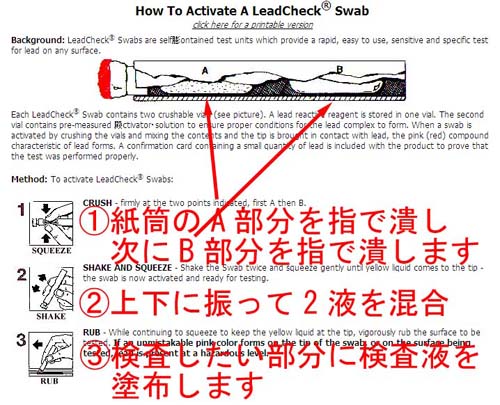
When we tested the surface of a metal accessory with plating, which is usually distributed in the world, no color change including lead was observed.
We would like to contact Hybrivet Systems to report why the color change of the reagent could not be confirmed by rubber cast containing a lot of lead, and report it.
There was a reply from Hybrivet Systems, and we re-tested.
Cause |
It was found that the result of this rubber cast was due to long and strong rubbing during the inspection. |
|---|---|
(I.e. |
As instructed by Hybrivet Systems, I first cleaned the test surface and lightly applied the test drug to it. As shown in the result on the right, it turned red indicating that it contained lead in less than 1 minute. However, since rubber cast contains tin, it will eventually turn purple as shown above as time passes. |
Result |
From the above results, it seems that it can be applied as a simple lead detection method for "problem of lead contained in metal accessories" using "Lead Check Swabs" of Hybrivet Systems. ..
Since there are many requests for purchase from us, we now sell it.
In addition to lead detection, there are also RoHS detection substances such as mercury, chromium, cadmium detection and nickel detection for allergy control.
Introduction of hazardous substance inspection reagents
| Product image | Inspection target | Detection limit | Sales price | Brand | Features |
|---|---|---|---|---|---|
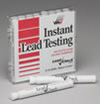 |
Pb (lead) |
Paint: 0.5% Surface: 1micro-g Liquid: 10-20ppm |
Please contact us | Hybrid Systems | It is very easy to use, and the test drug is rubbed on the target object for a few tens of seconds from the tip of the brush to see the reaction. Usually a yellow test drug will change from pink to red when it contains lead. |
 |
Pb (lead) |
Paint: 0.5% Surface: 1micro-g Liquid: 10-20ppm |
Please contact us | Hybrid Systems | It is very easy to use, and the test drug is rubbed on the target object for a few tens of seconds from the tip of the brush to see the reaction. Usually a yellow test drug will change from pink to red when it contains lead. |
 |
Cd (Cadmium) |
Surface: 1micro-g Liquid: 5ppm |
Please contact us | Hybrid Systems | It is very easy to use, and the test drug is rubbed on the target object for a few tens of seconds from the tip of the brush to see the reaction. Usually the yellow test drug turns pink to red when it contains cadmium. |
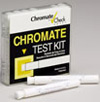 |
Cr (chrome) |
Surface: 1micro-g Liquid: 10-20ppm |
Please contact us | Hybrid Systems | It is very easy to use, and the test drug is rubbed on the target object for a few tens of seconds from the tip of the brush to see the reaction. Usually the yellow test drug will turn from pink to red when it contains chrome. |
 |
Hg (mercury) |
Surface: 1micro-g Liquid: 10-20ppm |
Please contact us | Hybrid Systems | It is very easy to use, and the test drug is rubbed on the target object for a few tens of seconds from the tip of the brush to see the reaction. Usually the yellow test drug will turn from pink to red when it contains mercury. |
 |
Ni (nickel) |
Surface: 1micro-g Liquid: 10ppm |
Please contact us | Hybrid Systems | It is very easy to use, and the test drug is rubbed on the target object for a few tens of seconds from the tip of the brush to see the reaction. Usually a yellow test drug will turn from pink to red when it contains nickel. |
Contact us.


